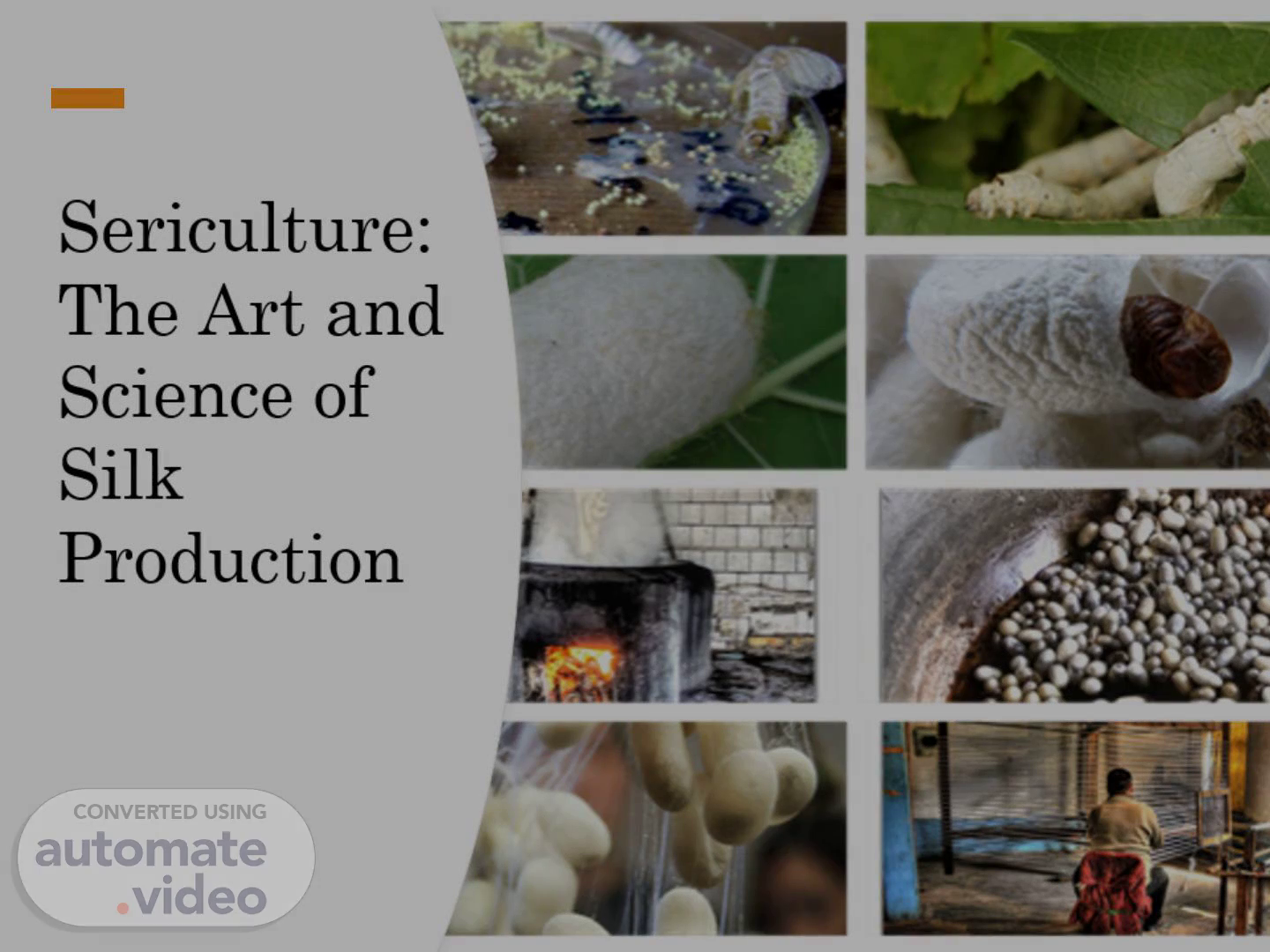Scene 1 (0s)
[image] A collage of images of white cocoons Description automatically generated.
Scene 2 (11s)
[Audio] By the end of this lecture, you will be able to: Understand the fundamentals of sericulture, including its historical significance and production processes. Analyze the challenges faced by the silk industry, especially in Pakistan, and propose solutions. Evaluate the economic, environmental, and future prospects of sericulture both globally and locally.".
Scene 3 (34s)
[Audio] Imagine traveling back thousands of years to ancient China, where a fascinating discovery changed the course of history. The story goes that one day, Empress Leizu was sipping tea under a mulberry tree. A mysterious cocoon fell into her cup, and as she tried to remove it, the cocoon began to unravel into a fine, shimmering thread. This marked the birth of silk production—an art known as sericulture. Initially, China guarded the secrets of silk-making with utmost care, ensuring it remained a prized national treasure for centuries. Over time, through trade routes like the legendary Silk Road, the knowledge spread to other regions, including Korea, Japan, and India. By the 6th century, sericulture reached Europe, becoming a symbol of luxury and wealth. Today, it has grown into a global industry, with countries like China, India, Japan, and Brazil leading silk production..
Scene 4 (1m 34s)
[Audio] The life cycle of a silkworm has four main stages: egg, larva, pupa, and adult moth. The most important stage for silk production is the larval stage when the silkworm spins a cocoon made of silk thread. Each cocoon can produce a continuous silk fiber that is approximately 1,000 meters long. Understanding this life cycle is essential for effective sericulture practices..
Scene 5 (1m 59s)
[Audio] "Moriculture refers to the cultivation of mulberry trees, which are the primary food source for silkworms. The quality of mulberry leaves directly impacts the quantity and quality of silk produced. Silkworm rearing involves carefully maintaining temperature, humidity, and cleanliness to ensure healthy growth and optimal cocoon production.".
Scene 6 (2m 21s)
[Audio] The stages of sericulture involve five key steps. It begins with moriculture, the cultivation of mulberry trees, whose leaves are the primary food for silkworms. Next is silkworm egg production, where silk moths lay eggs that are incubated until they hatch into larvae. In the rearing stage, the larvae are fed fresh mulberry leaves and grow through four molting phases..
Scene 7 (2m 43s)
[Audio] Once fully grown, the silkworms spin cocoons in the cocoon formation stage, producing a single silk thread that can stretch up to 1,000 meters. The final stage is silk reeling, where the cocoons are placed in hot water to loosen the silk threads, which are then unwound and twisted into silk yarn for textile production..
Scene 8 (3m 36s)
[Audio] "Pakistan has a long tradition of silk production, especially in areas like Khyber Pakhtunkhwa and Azad Kashmir. However, the industry is not as developed as in neighboring countries like China and India. Despite this, there is significant potential for growth, particularly if modern techniques and government support are introduced.".
Scene 9 (3m 59s)
[Audio] "The silk industry in Pakistan faces several challenges, including outdated farming techniques, lack of modern equipment, and a shortage of quality mulberry trees. However, the government has taken some steps to address these issues, such as launching training programs, promoting mulberry plantation drives, and investing in research and development to improve sericulture farms.".
Scene 10 (4m 21s)
[Audio] Sericulture has significant economic and environmental benefits. Economically, it provides employment opportunities, particularly in rural areas, and contributes to exports. Environmentally, mulberry trees help combat deforestation and soil erosion. Looking ahead, there is great potential for Pakistan to revive and grow its silk industry by adopting modern practices and increasing government and private sector investment.".
Scene 11 (4m 49s)
[Audio] o summarize, sericulture is a multifaceted industry with cultural, economic, and environmental significance. While Pakistan faces several challenges in its silk industry, there are also immense opportunities for growth. I encourage all of you to think about the role we can play in supporting the revival of this traditional craft. With the right policies and innovations, Pakistan's silk industry can thrive once again.".
